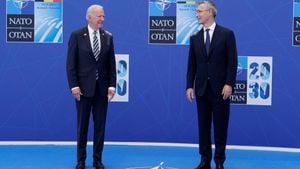The Russia-Ukraine War continues to escalate, bringing with it substantial losses and military shifts on both sides. Recent reports indicate significant Russian losses, particularly over the course of just 24 hours, which has raised alarms about the operational capabilities of their military forces.
According to the Ministry of Defense of Ukraine, Russia lost 194 vehicles and 64 artillery systems between November 13 and 14. These figures, described as the most considerable losses Russia has suffered within the past month, surprisingly reveal the staggering toll the invasion has taken on their military resources. The breakdown of the reported losses included 51 armored fighting vehicles and 19 tanks, along with 124 fuel tanks—a serious blow to their logistical capabilities.
While these statistics seem alarming, it’s worth mentioning Newsweek’s inability to independently verify these numbers, as Russia does not officially publish its military loss data. For several weeks, the fighting has intensified, particularly with the new surge of 50,000 troops reportedly deployed to the Kursk region.
Many of the additional troops are believed to have been recruited from North Korea, which has sparked questions about their combat readiness and experience. Observers have noted the potential risks associated with hastily recruited foreign troops being thrust headlong onto the battlefield—a situation some analysts have described as being akin to sending them to the proverbial “meat grinder.”
This influx of troops coincides with drone footage purportedly being taken from within the Kursk region. The imagery showcases waves of Russian vehicles moving toward the front lines, many of which have seemingly met with explosive results. The recent surge and its costly repercussions raise serious questions about the effectiveness of Russia's military strategy and capabilities.
Despite the mounting losses, Russia appears resolved to maintain control of the Kursk region—possibly to solidify its hold over territories it hopes to retain if future political dealings favor them. The upcoming changes within the American political sphere, particularly the potential return of Donald Trump to power, may influence Russia's calculations heavily. Trump has reportedly been engaging Russian officials about the possibilities of a ceasefire, hoping to reach an arrangement beneficial to Moscow.
At the heart of these discussions is Tulsi Gabbard, who Trump has nominated for the Director of Intelligence role. Gabbard's past statements have drawn scrutiny and accusations of spreading Russian propaganda, particularly about the United States supporting biological labs within Ukraine. While the U.S. government has acknowledged funding biological research facilities, critics have accused Gabbard of pushing conspiracy theories about the nature of these operations, a narrative previously dismissed by official statements from figures like Jen Psaki.
On the ground, the conflict rages on, with both sides continuing their military strategies amid growing unrest. Recently, another significant development occurred as one of the bridges used for logistical supply routes for the Russians collapsed. The bridge on the Dzhankoi-Maslove route, located within Russian-occupied Crimea, fell on November 13, resulting in injuries and disruption of transport links. Crimean Transport Minister Alexander Ovdienko remarked it had collapsed “spontaneously,” though investigations suggest the collapse was due to vehicles being overloaded on the bridge at the time.
Photographs and eyewitness accounts detailed the chaos as both vehicles fell and the structure crumbled, rendering it unserviceable and likely impacting military resupply efforts. The railway underneath—crucial for transporting military materials—has been gravely impacted, which means even more logistical challenges are to be faced by Moscow.
This bridge collapse serves as just one more indicator of the precarious situation affecting military logistics exacerbated by the war's continuing escalation. It mirrors prior incidents over the past year where infrastructure suffered severe damages, including the Kerch Bridge—Russia's prior attempts to solidify control over the territory. Ever since the initial annexation of Crimea, Russia has sought to extend its military dominance, yet incidents like these highlight vulnerabilities within their operational capabilities.
The Crimean peninsula remains pivotal for both combatants. Currently, Ukraine seeks to reclaim the territory lost during Russia’s 2014 annexation amid potential strategies for future actions aimed at regaining control over Crimea. Ukrainian efforts have seen them launching attacks approaching Crimea, with military leadership expressing determination to seize back what they believe is rightfully theirs.
Despite the dire situation on the battlefield, the international community is closely monitoring the developments, wary of the impacts not just within the region but potentially beyond its borders. The geopolitical repercussions extend over Europe, with nations considering how best to approach support for Ukraine and respond to the actions and decisions made by the Kremlin.
With the winter months approaching, military experts warn of the increasing urgency surrounding the conflict. It's not merely the gear affected—logistics, manpower, and morale all play cornerstones roles. The reality remains stark: both nations stand at pivotal moments, each maneuvering strategically amid the tumultuous tides of warfare, enjeux compelling yet layered with complexity within the international dispute.
The world watches, largely unable to predict outcomes. Yet, whatever happens next, it looks likely to be significant. This war continues to reshape territories and lives, with every report documenting loss and triumph on the battlefield defining the narrative of resilience amid chaos.



